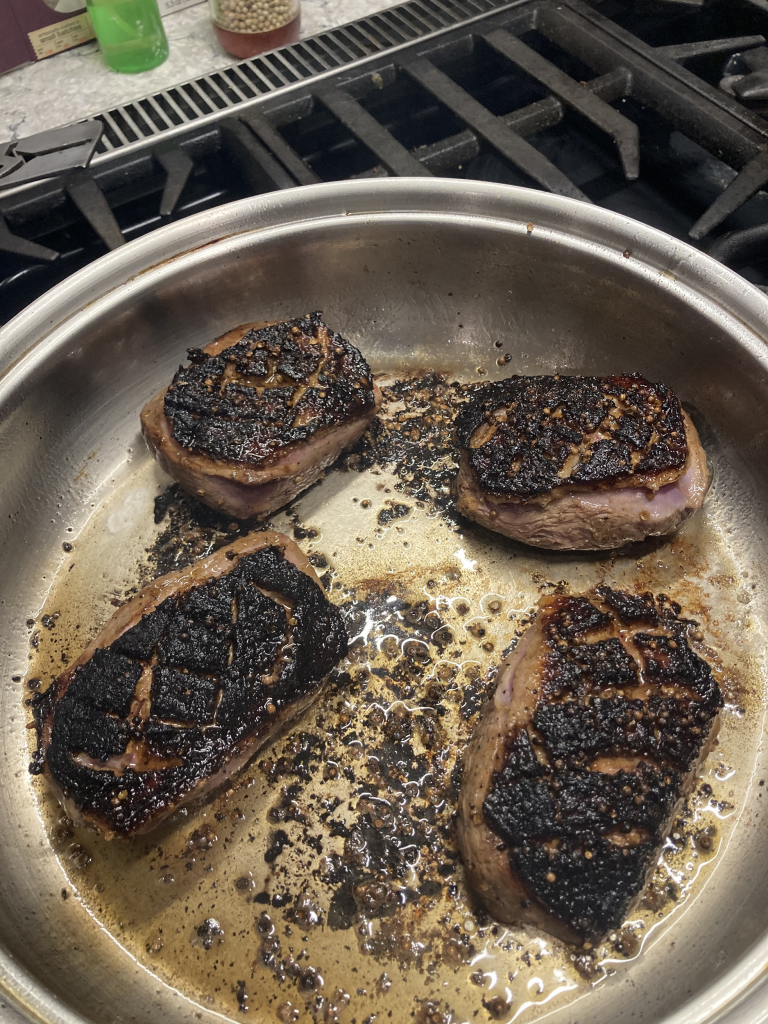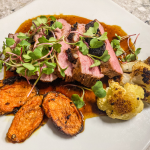Are you one of those who are afraid of cooking duck? I understand…I used to be one of those. Which is ironic because I grew UP eating roast goose. It’s just another water fowl…what IS the big deal?
Yet, even I have been intimidated by wanting to cook the perfect duck. I don’t do whole roast birds too often, but, a couple of duck breasts or legs seems manageable…I’ve shared duck recipes before, but this one is a really special dish, and is only somewhat involved.
New Year’s Eve seemed the perfect occasion to try something different: a spice-crusted duck breast, seared in a hot pan to render the fat under the skin and get a crisp on it…duck skin is the bacon of poultry if done right…and a perfect, juicy medium rare meat. Add a delicious sauce with the reduced pan drippings and there’s potential for bird nirvana.
And, according to my guests… that’s what I produced. Don’t be afraid, I’ll walk you through it.
First, you want to make sure your duck breasts are dry — that’s crucial for a good sear. Score your skin — well, by that I mean the duck’s. You’ll do a cross hatch cut in a diamond pattern being careful to cut JUST through the skin without nicking the meat. It may sound complicated but it’s really about making diagonal cuts in two directions. Take a peek at the picture below and you’ll see what I mean.

Another cool thing about this cut is that it allows you to get the spices from the rub deeply into the meat.
Get a pan REALLY hot so that when the duck hits the pan, there’s a noticeable hiss. You want to get a crisp on the duck, but then turn the pan down so that the skin doesn’t scorch, but the fat gets rendered so that you have crispy duck skin, not fatty, limp duck skin.
But, don’t be afraid of getting the skin dark…it’s part of the caramelizing process and all those bits clinging to the pan are part of why the sauce is so beguiling.

Once the breasts are seared enough, you’ll dump off the fat in the pan, flip the breasts meat side down and cook them a bit longer. At this point, they are pretty darned rare. Again, don’t stress. We are done yet.
The breasts go into a small roasting pan and into a preheated oven to finish cooking. That gives you time to make the sauce. Note: I know it may sound fussy to you, but producing REALLY great meals means you have all your ingredients prepped and set up ahead of time. For this recipe, it’s key because things happen fast once the duck is in the oven.
Your sauce will start with a deglaze of your searing pan. Scrape up all those fabulous dark bits and incorporate them in your sauce base. It’s where so much of the flavor comes from. Cognac or brandy will be what you deglaze with. If you don’t do alcohol, you don’t have to worry because nearly ALL of it burns off. But, if you really want to go pure, use a little apple juice or more of the orange juice for your deglaze liquid.
The next step is to make the caramel for the sauce, and it couldn’t be simpler. Melt granulated sugar in a hot skillet (non stick is best) until it’s deep golden in color, add a splash of vinegar to stop the caramelization process and incorporate that into your sauce base.

When the sauce is done, you’ll keep it barely warm while you slice your duck breasts for serving. Cut them on the bias, in even slices and fan out on the plates. Drizzle a little sauce over the duck and around the slices and you’re ready to serve! In my case, I oven roasted carrot slices (also cut on the bias) and cauliflower heads as my side and topped my duck with some radish microgreens for color and texture, but you can also serve them with garlic mashed potatoes, a puree of potato and celery root (celeriac) or any number of options.
I hope I’ve been able to help you over your fear of failing your duck. It really is easier than you think and the results are so worth it.
Caramelized Coriander Duck Breasts with Sweet & Sour Pan Sauce
Ingredients
- 4 boneless duck breasts
Marinade
- 1/4 cup cognac or brandy
- 1/4 cup low-sodium soy sauce
- 1/2 cup pineapple juice See notes, below
- 1/2 tsp minced or grated ginger
Rub
- 2 Tbsp coriander seeds, crushed
- 1 tsp kosher salt
- 1/2 tsp freshly ground black pepper
- 1 tsp granulated sugar
Pan Sauce
- 1/4 cup Grand Marnier
- 1/2 cup orange juice
- 1/4 cup rich veal stock or demi glace
- 1/2 cup granulated sugar
- 2 tsp fig or raspberry vinegar
- 1 tsp cornstarch mixed with 1/8 cup cold water
- grated zest from one orange
Instructions
To prepare duck breasts
- Rinse duck breasts under cold water and pat dry. Using a very sharp knife, score the skin of the breast in a diamond pattern, taking care not to cut into the meat.
- Combine all marinade ingredients. Place the duck breasts, skin side down initially, in the marinade for 30 minutes. Turn the duck breasts occasionally during this time so the marinade can soak into meat evenly.
- Combine all the rub ingredients. Remove duck breasts from the marinade and pat dry. Coat breasts with the rub, pushing it into both sides of the meat.
- Preheat oven to 450°.
- Place a heavy-bottomed saute pan over medium-high heat and allow it to get very hot. Place the duck breasts into the pan, skin side down. You should be able to hear a sizzle when the skin hits the pan surface. Continue to cook the duck, allowing the fat to render, but not allowing the duck to scorch. If excess fat develops, remove it from the pan. Cook duck breast until the skin is nice and brown, about 7-8 minutes.
- When the skin is dark brown and all the extra fat has been removed from the pan, flip breasts over and cook meat-side down for 2-3 minutes. The breasts will still be quite rare at this point.
- Remove duck breasts from the pan, place them into a small roasting pan, meat side down. Place roasting pan in the preheated oven and cook for 8-10 minutes, or until thermometer reads 135° at the thickest point (for medium rare). Remove the pan from the oven, pour off the fat and place on a warm serving platter, cover and allow to rest 4-5 minutes in a warm place.
For the sauce
- Deglaze the pan by adding the Grand Marnier to hot drippings and scrape up browned bits with a whisk or wooden spoon. Place the pan over medium heat. Add the orange juice and veal stock or demi glace, stirring constantly. If you like bits in your sauce, you can proceed now to the next step. If you like a smoother sauce, strain it first before continuing.
- In a large, dry skillet, ideally non-stick, over high heat, melt the sugar. The sugar will dissolve into a clear liquid and begin to brown quickly. As it nears the caramelized state, stir the melted sugar. It will begin to foam slightly with small bubbles, and a deep brown color. Remove the pan from the heat and stir in the fig or raspberry vinegar.
- Add the reserved pan sauce to the sugar-vinegar mixture and bring to a boil. Adjust the thickness of the sauce by adding the cornstarch and water slurry. Finish sauce by adding orange zest.
To serve duck breasts
- Slice each duck breast on a bias and fan out slices on a dinner plate, with the skin side up. Drizzle some of the sauce over and around the duck breast. Garnish with some microgreens, if you have them, or simply grind some fresh black pepper around and on the duck breasts. Serve immediately.






